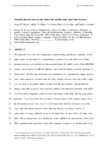Transient pressure waves in the vadose zone and the rapid water table response

View/
Date
2013Author
Waswa, George W.
Clulow, Alistair D.
Freese, Carl
A.L, Peter
Roux, Le
Lorentz, Simon A.
Metadata
Show full item recordAbstract
The behaviour of a water table is important in understanding groundwater dynamics. In this 11
paper, results are presented of a disproportionate response of a water table in two distinct 12
transient pressure wave mechanisms that occurred during the rainfall events of the 2000/2001 13
summer season and in two different hillslope zones in the Weatherley research catchment of 14
South Africa. The first type of pressure wave mechanism was a groundwater ridging pressure 15
wave, which frequently occurred at the low-lying wetland zone and when the capillary fringe 16
was very close to the ground surface. Results from this zone indicated that groundwater 17
ridging water table responses were caused by rainfall events that had a threshold total rainfall 18
of 10 mm and the magnitude of the responses had a linear relationship with the peak rainfall 19
intensities. It was also found that the release of tension forces in the capillary fringe, due to 20
the downward pressure wave, was 2.5 to 22.5 times faster than the subsequent rise of the 21
water table (the upward pressure wave). This later finding, according to the law of 22
conservation of energy, indicated an on-set of a lateral flow of water, below the rising water 23
table. The second pressure wave mechanism, which exhibited the characteristics of the Lisse 24
Effect (pneumatically pressurized water table response), occurred at an elevated zone of the catchment, where bedrock is overlain by a shallow soil profile and a perched groundwater. 26
This second pressure wave mechanism was particularly evident during a certain rainfall event 27
that occurred in the early part of the season. During this rainfall event, a peak rainfall intensity 28
of 228 mm/h generated a pressure wave from the ground surface towards the water table, 29
where it rapidly and disproportionately elevated the hydraulic head in groundwater by 106 30
cm-H2O, at the toe of the slope and without the recharge of the groundwater by the infiltration 31
profile. The elevated hydraulic head at the toe of the slope rapidly overturned the hydraulic 32
gradients, from 0.0100, in the downslope direction, to 0.0105, in the upslope direction, in just 33
24 minutes. The overturned hydraulic gradients reversed the flow of water from a downslope 34
direction to an upslope direction. The overturning wave, which originated with an elevated 35
pressure potential of 106 cm-H20, at the downslope observation nest, travelled with an 36
average velocity of 2 m/h and arrived at an adjacent observation nest, 46 m up the slope, with 37
an attenuated pressure potential of 31 cm-H2O. A laboratory experiment was performed to 38
verify this second transient pressure wave mechanism and to investigate the involved 39
processes. Results from the laboratory experiment verified that the second pressure wave was 40
the Lisse Effect and that, as in the groundwater ridging, the capillary fringe plays a significant 41
role in the rapid response of the water table. In conclusion, both the Lisse Effect and 42
groundwater ridging may result in disproportionate groundwater fluxes, which is successively 43
caused by the conversion of the capillary fringe and a disproportionately rapid water table
